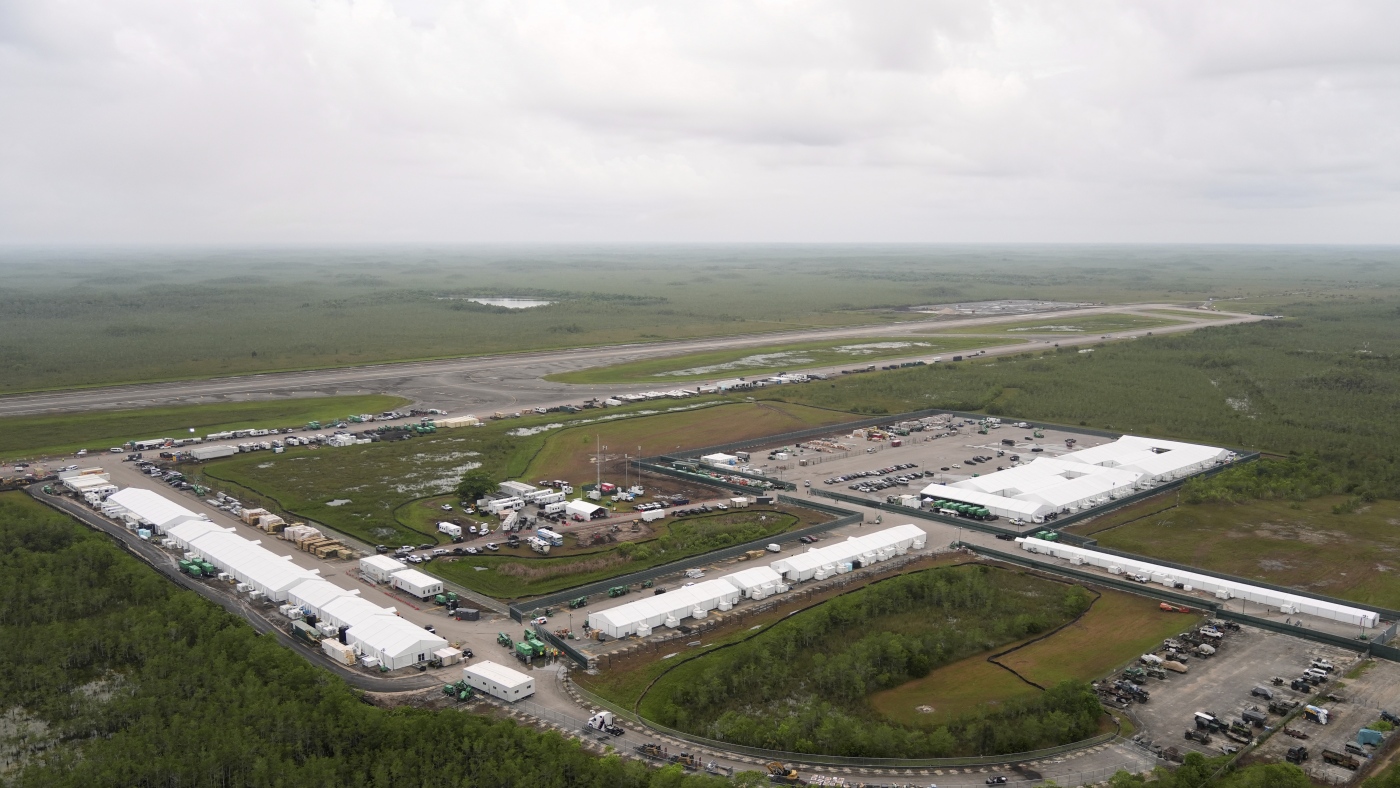Controversy Surrounding Florida's Plans for Second Immigration Detention Facility
Introduction
In a controversial move, Florida Republican Governor Ron DeSantis has announced plans to open a second immigration detention facility at a state prison in north Florida. This second facility has been dubbed the 'Deportation Depot' by critics, adding to the already heated debate surrounding the state's immigration policies.
Key Details
The decision to open a second detention facility comes as a federal judge is currently ruling on the fate of the state's current holding center for immigrants at an isolated airstrip. The proposed 'Deportation Depot' will be located at an already existing state prison, which has raised concerns about the safety and well-being of both the detainees and the employees at the facility.
This move also raises questions about the state's motives and intentions, as Florida has been known for its strict immigration policies and its cooperation with federal immigration authorities.
Impact
The potential opening of a second detention facility has sparked outrage and protests from immigrant rights groups and activists. The 'Deportation Depot' has been labeled as inhumane and a clear violation of human rights by those who oppose it.
The impact of this decision is not limited to just the state of Florida, as it adds to the larger national conversation surrounding immigration policies and the treatment of immigrants in detention centers.
About the People Mentioned
Ron DeSantis
Ron DeSantis is a prominent conservative Republican politician who has served as the 46th Governor of Florida since January 8, 2019. Born on September 14, 1978, in Jacksonville, Florida, DeSantis grew up in Dunedin with blue-collar roots. He attended Yale University, where he graduated with honors and captained the varsity baseball team. He later earned his law degree from Harvard Law School, earning a commission in the U.S. Navy as a Judge Advocate General (JAG) officer during his time there[1][2][3]. DeSantis's military career included deployments to Iraq, where he supported SEAL missions in Fallujah and Ramadi, earning the Bronze Star Medal for meritorious service[1][2]. After his military service, he worked as a federal prosecutor, focusing on child predator cases. DeSantis was elected to the U.S. House of Representatives in 2012, representing Florida's Sixth District until 2018. He gained recognition for his fiscal conservatism and alignment with the Tea Party movement[2][3]. As Governor of Florida, DeSantis has been at the forefront of several contentious issues, including COVID-19 policies, education reform, and voter fraud concerns. Notably, he lifted pandemic restrictions early, while implementing measures to protect vulnerable populations[3]. His administration has also focused on expanding school choice, promoting public safety, and investing in environmental conservation[4]. In 2023, DeSantis announced his candidacy for the 2024 U.S. presidential election but suspended his campaign in January 2024, endorsing Donald Trump[2]. His tenure as governor continues to shape Florida's political landscape and influence national discussions on conservative policies. DeSantis is married to Casey DeSantis, and they have three children together[1][4].
About the Organizations Mentioned
Republican Party
The **Republican Party**, also known as the **GOP (Grand Old Party)**, is one of the two major political parties in the United States, founded in 1854 primarily by anti-slavery activists opposing the Kansas-Nebraska Act and the expansion of slavery into U.S. territories[1][5]. It was formed from a coalition of former Whigs, Democrats, and Free Soil party members who shared opposition to slavery and a desire for a national political force promoting economic development and social order[2][5]. The party's early base included northern Protestants, businessmen, factory workers, professionals, and prosperous farmers. It strongly supported pro-business policies like the national banking system, the gold standard, railroads, and high tariffs[1][3]. Abraham Lincoln, the first Republican president elected in 1860, led the party through the Civil War, championing the abolition of slavery and the preservation of the Union. This solidified the GOP’s dominance in national politics for decades, especially in the North, while it remained weak in the South[1][5][6]. Historically, the Republican Party was instrumental in major social reforms, including the Emancipation Proclamation and the passage of the 13th, 14th, and 15th Amendments, which abolished slavery, guaranteed equal protection, and secured voting rights for African Americans, respectively[6]. The party also supported women's suffrage early on, backing the 19th Amendment[6]. In the 20th century, Republicans were associated with both conservative economic policies—favoring reduced taxes, limited government regulation, and individual economic freedom—and a strong national defense[7]. The party experienced ideological splits, notably in 1912 when Theodore Roosevelt led a progressive faction away from the conservative wing[1][5]. Today, the GOP continues to promote conservative social policies and states’ rights, opposing extensive federal intervention and advocating free-market principles[7]. For readers interested in business and technology,
Deportation Depot
## Overview "Deportation Depot" is not a traditional business or technology organization, but rather a new migrant detention facility established by the state of Florida under the leadership of Governor Ron DeSantis[1][2]. It is a state-operated immigration detention center, designed to hold individuals subject to deportation, and reflects a significant expansion of Florida’s role in immigration enforcement—a function historically managed at the federal level[1][4]. ## What It Does The Deportation Depot is a repurposed former state prison—the Baker Correctional Institution in Sanderson, North Florida—converted to detain and process migrants awaiting deportation[1][2]. The facility, which began accepting detainees in late 2025, currently holds over 100 individuals but has a capacity for more than 1,300, with potential expansion up to 2,000[2][5]. Its operations are intended to supplement another controversial Florida facility, "Alligator Alcatraz," located in the Everglades[1][2]. Both centers are part of a broader state initiative to increase detention and deportation capacities, with Florida officials emphasizing rapid processing and removal of those they classify as "illegal aliens"[1][3]. ## History and Legal Context The opening of Deportation Depot marks a new chapter in state-federal immigration enforcement partnerships. Traditionally, immigration detention has been a federal responsibility, with local jails occasionally holding individuals briefly for federal authorities. However, Florida’s approach—operating large-scale, long-term detention centers under agreements like the 287(g) Program—is unprecedented in both scale and ambition[4]. This expansion has raised legal and ethical questions, with critics arguing that the blurred lines between state and federal custody increase the risk of rights violations and abuse[4]. ## Key Achievements and Current Status From the state’s perspective, the rapid conversion and opening of Deportation Depot—alongside the continued operation of Alligator Alcatraz despite legal
Federal Immigration Authorities
The term "Federal Immigration Authorities" broadly refers to the United States federal agencies responsible for administering, enforcing, and adjudicating immigration laws. These agencies operate under different departments, primarily the Department of Homeland Security (DHS) and the Department of Justice (DOJ), each with specialized functions. Historically, immigration enforcement was managed by the Immigration and Naturalization Service (INS) within the DOJ until 2002. Post-9/11 security reforms led to the Homeland Security Act of 2002, which abolished INS and transferred immigration responsibilities to DHS. DHS now houses three key agencies: U.S. Citizenship and Immigration Services (USCIS) handling immigration benefits and naturalization; Immigration and Customs Enforcement (ICE) focusing on enforcement and removal; and Customs and Border Protection (CBP), which manages border security and customs enforcement[2][5]. The DOJ retains immigration adjudication authority through the Executive Office for Immigration Review (EOIR), which includes the Board of Immigration Appeals (BIA)—the highest administrative body interpreting immigration laws. EOIR also comprises administrative offices supporting policy, IT infrastructure, and operational management[1]. Key achievements of these federal immigration authorities include the establishment of a structured and layered immigration system capable of processing millions of applications, enforcing immigration laws, and managing complex adjudications. Technological advancements, driven by EOIR’s Office of Information Technology and USCIS, have modernized case processing and data management, enhancing efficiency and transparency. Currently, federal immigration authorities oversee a complex system involving visa categories, asylum, enforcement, and citizenship pathways. Numerical limits and per-country ceilings regulate immigration flows, balancing economic needs with national security[4]. The agencies continue to evolve amid changing immigration policies and technological integration, remaining critical players in U.S. immigration governance. Notably, their work intersects closely with legal, humanitarian, and labor domains, reflecting the multifaceted challenges of immigration management in a dynamic global context. Their ongoing adaptations to policy, technology, and enforcement practices make the
Immigrant Rights Groups
## Immigrant Rights Groups: Overview and Impact The term “Immigrant Rights Groups” refers not to a single organization, but to a broad network of nonprofits, coalitions, and advocacy organizations dedicated to protecting and advancing the rights of immigrants in the United States. These groups engage in a wide range of activities, including legal defense, policy advocacy, community education, and litigation, often with a focus on marginalized and low-income immigrant communities. ## Mission and Activities Immigrant rights organizations such as the Immigrant Legal Resource Center (ILRC), Amica Center for Immigrant Rights, and the National Immigration Law Center (NILC) provide direct legal services, train attorneys and advocates, and engage in strategic litigation to challenge unjust immigration policies[1][2][8]. They also work to shape public policy by informing lawmakers, the media, and the public, and by mobilizing grassroots support for pro-immigrant reforms[1][4]. Coalitions like Protecting Immigrant Families (PIF) unite hundreds of organizations nationwide to safeguard access to health care, nutrition, and other essential services for immigrant families[5]. ## History and Evolution Many of these groups were founded in response to the growing complexity and harshness of U.S. immigration enforcement. For example, the National Immigration Forum has advocated for responsible federal policies since 1982, while United We Dream emerged as the largest immigrant youth-led network, focusing on the unique challenges faced by young immigrants[1][6]. Over the decades, these organizations have evolved to address emerging issues such as family separation, detention conditions, and the intersection of immigration and criminal justice[4][7]. ## Key Achievements Notable successes include landmark litigation, such as the Northwest Immigrant Rights Project’s class action cases that have forced the government to improve due process protections for asylum seekers[7]. Advocacy by groups like the ILRC and NILC has led to local policy changes that limit cooperation between local law enforcement and federal immigration authorities,
Activists
The term "Activists" generally refers to individuals or groups engaged in efforts to promote or oppose social, political, economic, or environmental reforms aimed at achieving a common good. Activists employ diverse methods, including grassroots organizing, advocacy, protests, digital campaigns, and more technical approaches such as hacktivism. These actions range from community-based petition drives and educational outreach to large-scale demonstrations and strategic litigation[2]. While "Activists" as a specific organization is not directly identified in the search results, the concept encompasses a wide array of formal and informal groups and movements worldwide. Many activist organizations work within the nonprofit sector, often innovating beyond traditional hierarchical models to incorporate sociocratic governance, worker self-direction, or decentralized "swarm" structures to increase participation, accountability, and alignment with activist values[6]. This evolution reflects a response to critiques of the "non-profit industrial complex" and aims to deepen democratic engagement and social movement connectivity. Key activist organizations with historical significance and ongoing influence include the NAACP, which fights for civil rights and social justice for Black Americans through advocacy, agitation, and litigation, continuing the legacy of leaders like W.E.B. Du Bois and Thurgood Marshall[3]. Amnesty International's activist groups mobilize grassroots human rights activism across communities, supporting both local and virtual engagement to defend human rights[4]. Activism today is closely intertwined with technology and social media, facilitating civic engagement and collective action. Left-wing and right-wing activists use distinct online strategies, from hashtag activism and offline protests to media manipulation and platform migration[2]. This technological integration makes activism particularly relevant in business and technology news, highlighting how digital tools reshape social movements. Notable aspects of activism include its broad scope—from economic boycott campaigns to artivism and hacktivism—and its fine line with other forms of political action, sometimes blurring with extremism or terrorism in perception[2]. Activists have historically leveraged literature and now digital media to spread their messages effectively. In summary





